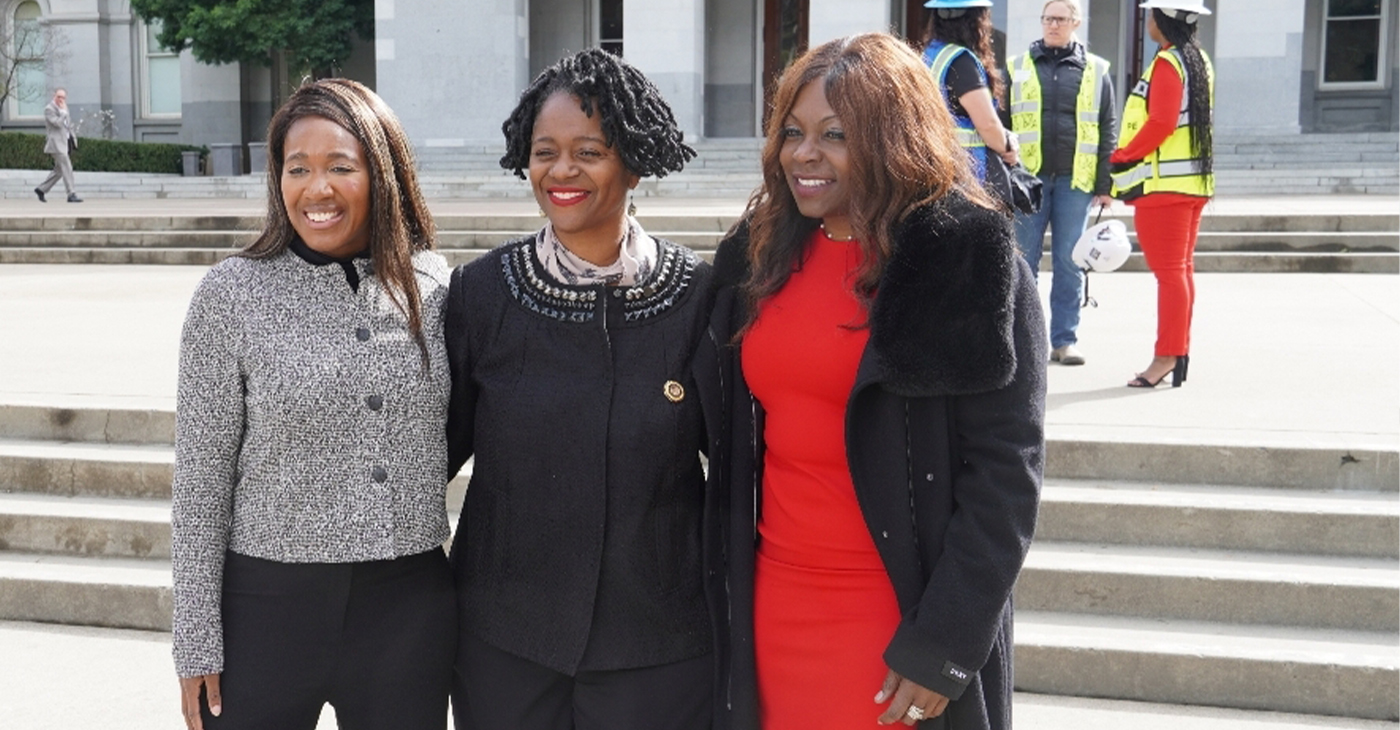National
Racial Disparities in Early Childhood Hurts U.S.

Ready Freddy visits prekindergarten students at a public school in Buffalo, N.Y. (David Duprey/AP Photo)
By Jazelle Hunt
Washington Correspondent
WASHINGTON (NNPA) –Increased investment in early childhood education and care can eradicate many of the racial success gaps that persist throughout society, according to a new report from the Center for American Progress (CAP).
Early childhood encompasses birth through 3 years old, and children of color are already the majority in this as-yet-unnamed generation.
The report, titled, “Investing in Infants and Toddlers to Combat Inequality,” shows that despite being the majority, children of color are generally faring poorly on a number of social and educational metrics. One -in-three toddlers of color lives in poverty. By 5 years old, children from low-income homes have heard millions of words fewer than their more affluent peers (a vocabulary deficit known as the word gap).
According to an earlier CAP report, even among middle- and upper-class families, 25 percent of all kindergarteners are not school-ready – they may not know any letters, numbers, or colors, for example.
“While the United States as a whole has become an increasingly educated country over time, very significant educational disparities exist between whites and people of color,” the report states. “Since the majority of infants are children of color, improving the continuum of early childhood programs available to children under age 3 and their families provides an opportunity to stifle these disparities before they begin.”
Data suggests that without intervention to beef up early education programs, this generation may not be able to meet economic demands to maintain the United States as a world leader. Among 25 to 29 year olds in 2012, only 37 percent of Whites, 17 percent of Blacks, and 13 percent of Hispanics held at least a bachelor’s degree.
According to the report, if current educational attainment trends continue, 5 million jobs over the next decade will go unfilled or be outsourced for lack of skilled, educated American workers.
Further, if racial income gaps had been closed in 2011, national GDP would have increased by $1.2 trillion and an additional $192 billion in taxes would have been generated.
“If the heart doesn’t get us – the importance of helping [the babies]…the other thing that should get us are the economic implications,” said David Johns, executive director of the White House Initiative on Educational Excellence for African Americans, speaking as part of a panel event connected to the report release. “So many of our communities would be saved if we would just find the time to make intentional investments in children and families, early.”
The foundation for today’s early childhood programs were the result of largely successful social and educational experiments primarily tested with Black children and families. Generally, families of color now lack access to affordable, high quality programs. Part of it is cost. The report asserts that the cost of childcare is higher than the median rent in all 50 states. It also asserts that most of the nation’s childcare options are poor or mediocre in quality, despite this high cost.
The federal government offers several provisions for the youngest among us, and their parents. Some are more effective than others. The Child Care Development Block Grant, for example, allows states to give low-income families childcare subsidies. But, the report points out, while the subsidies free up low-income parents to attend school, work, or technical training, the subsidies don’t match the cost of high-quality programs; so such programs usually do not accept these vouchers.
There’s also Early Head Start (EHS) and the very popular Head Start program. These programs, which have benefitted Black families in particular, provide a spread of pre- and post-natal health services, child development, and educational services to low-income infants and toddlers.
“Research on the effectiveness of EHS shows positive effects on development for infants and toddlers, including a wide range of cognitive and social-behavioral out- comes, and on child-rearing practices for mothers,” the report explains. “These beneficial effects were markedly large for African American children, including an increase in parental support for early language and literacy, daily reading, and teaching activities through age 5.”
But, Head Start is “severely underfunded,” serving less than 5 percent of the nation’s infants and toddlers.
During the CAP panel, the speakers explained that parents can bolster early childhood development by spending a lot of face time with their children: talking, reading, and making up stories. The simple activities can go along way toward academic success later in life.
“We spend a lot of time and a lot of resources attempting to catch up, and to close both opportunity and achievement gaps that would not exist if we were to start early – at the time that baby is in utero, and at the time in which the foundation upon which all future learning and development is taking place and is actually being formed,” Johns said.
“There’s so much more work to do to ensure that everyone understand the importance of [early childhood] and then that they’re able to properly invest in it.”
###
Activism
Oakland Post: Week of March 28 – April 1, 2025
The printed Weekly Edition of the Oakland Post: Week of March 28 – April 1, 2025

To enlarge your view of this issue, use the slider, magnifying glass icon or full page icon in the lower right corner of the browser window.
Activism
Sen. Lola Smallwood-Cuevas Honors California Women in Construction with State Proclamation, Policy Ideas
“Women play an important role in building our communities, yet they remain vastly underrepresented in the construction industry,” Smallwood-Cuevas stated. “This resolution not only recognizes their incredible contributions but also the need to break barriers — like gender discrimination.

By Antonio Ray Harvey, California Black Media
To honor Women in Construction Week, Sen. Lola Smallwood-Cuevas (D-Los Angeles), a member of the California Legislative Black Caucus (CLBC), introduced Senate Concurrent Resolution (SCR) 30 in the State Legislature on March 6. This resolution pays tribute to women and highlights their contributions to the building industry.
The measure designates March 2, 2025, to March 8, 2025, as Women in Construction Week in California. It passed 34-0 on the Senate floor.
“Women play an important role in building our communities, yet they remain vastly underrepresented in the construction industry,” Smallwood-Cuevas stated. “This resolution not only recognizes their incredible contributions but also the need to break barriers — like gender discrimination.
Authored by Assemblymember Liz Ortega (D-San Leandro), another bill, Assembly Concurrent Resolution (ACR) 28, also recognized women in the construction industry.
The resolution advanced out of the Assembly Committee on Rules with a 10-0 vote.
The weeklong event coincides with the National Association of Women In Construction (NAWIC) celebration that started in 1998 and has grown and expanded every year since.
The same week in front of the State Capitol, Smallwood, Lt. Gov. Eleni Kounalakis, Assemblymember Josh Hoover (R-Folsom), and Assemblymember Maggie Krell (D-Sacramento), attended a brunch organized by a local chapter of NAWIC.
Two of the guest speakers were Dr. Giovanna Brasfield, CEO of Los Angeles-based Brasfield and Associates, and Jennifer Todd, President and Founder of LMS General Contractors.
Todd is the youngest Black woman to receive a California’s Contractors State License Board (A) General Engineering license. An advocate for women of different backgrounds, Todd she said she has been a woman in construction for the last 16 years despite going through some trying times.
A graduate of Arizona State University’s’ Sandra Day O’Connor College of Law, in 2009 Todd created an apprenticeship training program, A Greener Tomorrow, designed toward the advancement of unemployed and underemployed people of color.
“I always say, ‘I love an industry that doesn’t love me back,’” Todd said. “Being young, female and minority, I am often in spaces where people don’t look like me, they don’t reflect my values, they don’t reflect my experiences, and I so persevere in spite of it all.”
According to the U.S. Bureau of Labor Statistics, only 11.2% of the construction workforce across the country are female. Overall, 87.3% of the female construction workers are White, 35.1% are Latinas, 2.1% are Asians, and 6.5% are Black women, the report reveals.
The National Association of Home Builders reported that as of 2022, the states with the largest number of women working in construction were Texas (137,000), California (135,000) and Florida (119,000). The three states alone represent 30% of all women employed in the industry.
Sen. Susan Rubio (D-Baldwin Park) and the California Legislative Women’s Caucus supported Smallwood-Cuevas’ SCR 30 and requested that more energy be poured into bringing awareness to the severe gender gap in the construction field.
“The construction trade are a proven path to a solid career. and we have an ongoing shortage, and this is a time for us to do better breaking down the barriers to help the people get into this sector,” Rubio said.
Activism
Report Offers Policies, Ideas to Improve the Workplace Experiences of Black Women in California
The “Invisible Labor, Visible Struggles: The Intersection of Race, Gender, and Workplace Equity for Black Women in California” report by the California Black Women’s Collective Empowerment Institute (CBWCEI), unveiled the findings of a December 2024 survey of 452 employed Black women across the Golden State. Three-fifths of the participants said they experienced racism or discrimination last year and 57% of the unfair treatment was related to incidents at work.

By McKenzie Jackson, California Black Media
Backed by data, a report released last month details the numerous hurdles Black women in the Golden State must overcome to effectively contribute and succeed in the workplace.
The “Invisible Labor, Visible Struggles: The Intersection of Race, Gender, and Workplace Equity for Black Women in California” report by the California Black Women’s Collective Empowerment Institute (CBWCEI), unveiled the findings of a December 2024 survey of 452 employed Black women across the Golden State. Three-fifths of the participants said they experienced racism or discrimination last year and 57% of the unfair treatment was related to incidents at work.
CBWCEI President and CEO Kellie Todd Griffin said Black women have been the backbone of communities, industries, and movements but are still overlooked, underpaid, and undervalued at work.
“The data is clear,” she explained. “Systemic racism and sexism are not just historical injustices. They are active forces shaping the workplace experiences of Black women today. This report is a call to action. it demands intentional polices, corporate accountability, and systemic changes.”
The 16-page study, conducted by the public opinion research and strategic consulting firm EVITARUS, showcases the lived workplace experiences of Black women, many who say they are stuck in the crosshairs of discrimination based on gender and race which hinders their work opportunities, advancements, and aspirations, according to the report’s authors, Todd Griffin and CBWCEI researcher Dr. Sharon Uche.
“We wanted to look at how Black women are experiencing the workplace where there are systematic barriers,” Todd Griffin told the media during a press conference co-hosted by Ethnic Media Services and California Black Media. “This report is focused on the invisible labor struggles of Black women throughout California.”
The aspects of the workplace most important to Black women, according to those surveyed, are salary or wage, benefits, and job security.
However, only 21% of the survey’s respondents felt they had strong chances for career advancement into the executive or senior leadership ranks in California’s job market; 49% felt passed over, excluded from, or marginalized at work; and 48% felt their accomplishments at work were undervalued. Thirty-eight percent said they had been thought of as the stereotypical “angry Black woman” at work, and 42% said workplace racism or discrimination effected their physical or mental health.
“These sentiments play a factor in contributing to a workplace that is unsafe and not equitable for Black women in California,” the report reads.
Most Black women said providing for their families and personal fulfillment motivated them to show up to work daily, while 38% said they were dissatisfied in their current job with salary, supervisors, and work environment being the top sources of their discontent.
When asked if they agree or disagree with a statement about their workplace 58% of Black women said they feel supported at work, while 52% said their contributions are acknowledged. Forty-nine percent said they felt empowered.
Uche said Black women are paid $54,000 annually on average — including Black single mothers, who averaged $50,000 — while White men earn an average of $90,000 each year.
“More than half of Black families in California are led by single Black women,” said Uche, who added that the pay gap between Black women and White men isn’t forecasted to close until 2121.
-

 Activism4 weeks ago
Activism4 weeks agoUndocumented Workers Are Struggling to Feed Themselves. Slashed Budgets and New Immigration Policies Bring Fresh Challenges
-

 Activism4 weeks ago
Activism4 weeks agoOakland Post: Week of March 5 – 11, 2025
-

 Activism1 week ago
Activism1 week agoWe Fought on Opposite Sides of the Sheng Thao Recall. Here’s Why We’re Uniting Behind Barbara Lee for Oakland Mayor
-

 #NNPA BlackPress2 weeks ago
#NNPA BlackPress2 weeks agoRev. Dr. Jamal Bryant’s Black Church Target Boycott Mobilizes 150,000
-

 Activism2 weeks ago
Activism2 weeks agoSan Francisco Is Investing Millions to Address Food Insecurity. Is Oakland Doing the Same?
-

 #NNPA BlackPress4 weeks ago
#NNPA BlackPress4 weeks agoTrump Moves to Dismantle Education Department
-

 #NNPA BlackPress4 weeks ago
#NNPA BlackPress4 weeks agoFighting to Keep Blackness
-

 #NNPA BlackPress4 weeks ago
#NNPA BlackPress4 weeks agoFederal Firing Leaves Gaping Holes

























































Pingback: Racial Disparities in Early Childhood Hurts U.S. | Milwaukee Courier Weekly Newspaper
Pingback: Racial Disparities in Early Childhood Hurts U.S. | Milwaukee Courier Weekly Newspaper